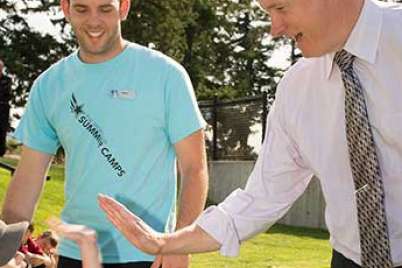
Toddlers will have fun and develop skills at circus school
Remember when your parents jokingly said they would send you away to the circus?
The empty threat was often in response to kids who seemed out of control, but for a growing number of parents circus school has become a new way to lay a foundation for physical literacy.
Heather Kentner, director and founder of Cirque-ability, welcomes hundreds of students, young and old, to her Toronto studio for aerial and acrobatic classes. Around half of the participants are 12-and-under, illustrating a growing interest in circus-inspired classes as a way of keeping kids active and learning new skills.
“Circus is very multi-disciplinary which allows for the introduction of many skills and movements that benefit not only circus skills, but provide a foundation for many sports,” says Heather.
A gymnast most of her life, Heather began circus arts in university and coached gymnastics and circus arts while touring and performing with the city’s top circus companies. She turned her focus back to coaching when she opened Cirqu-ability nearly 10 years ago.
“Many parents think that they should enroll their kids in circus classes because their kids are ‘monkeying around,’” explains Heather.
But she points out that circus classes are a great fit for all children.
“It’s really special to see kids build a wide variety of skills that they didn’t have before,” she says.
After a series of classes, she says that many parents begin to see their children approach the playground or run around with their friends with a new confidence in themselves.
Many of the little acrobats are barely walking when they start.
Children in the youngest age group (1 to 3 years) have the benefit of one-on-one attention from their caregiver or parent who are there to encourage and “spot” their tot during the various activities.
But according to Heather, starting at this age is so important as “it builds confidence and fundamental movement skills before they start playing sports, and that really gives them a head start in sports.”
Through acrobatics, aerial arts, trampoline, object manipulation, slackline, and theatrics, the smallest tumblers are introduced to jumping, running, landing, climbing, rolling, spinning, balancing, moving, throwing, and catching.
Heather gives these examples on how circus movements can build physical literacy skills:
- Grasping an aerial apparatus like a trapeze helps develop hand-eye coordination and upper body strength.
- Lifting toes to the bar helps with core strength and coordination. While this allows for skill progression in aerial arts and in other sports, it even aids in building the strength kids need for writing.
- Flipping into an upside-down straddle in an aerial silks knot builds strength and coordination and develops spatial awareness.
- Object manipulation such as juggling balls, ribbons, hula hoops, and little teddy bears helps with ball-handling skills like catching, throwing, rolling, and kicking, needed in ball sports.
- Every new circuit or obstacle course helps children practice the skills they’ve already learned on different equipment and build confidence in themselves and their ability to move their body.





